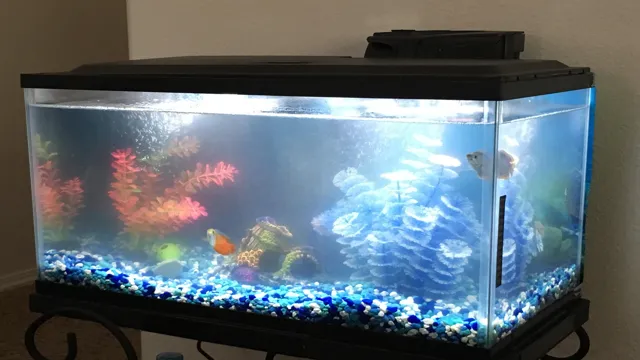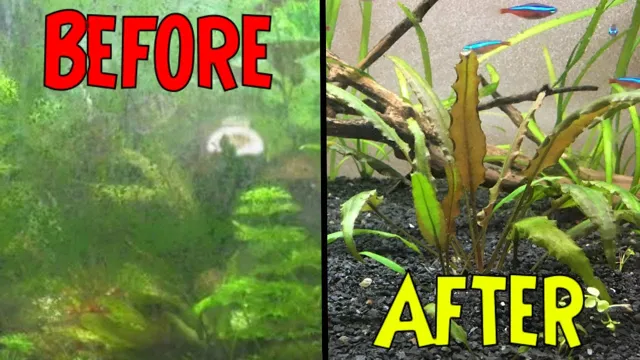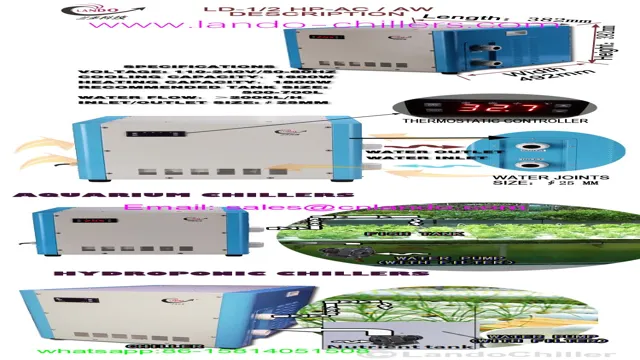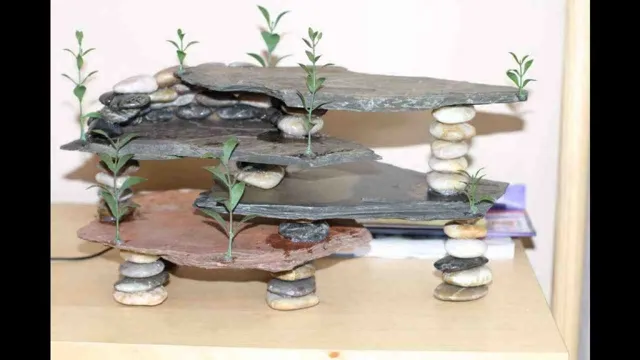Do you dream of having a crystal-clear aquarium that showcases the beauty of your fish and plants? Is cloudy water ruining your visual experience, causing frustration and concern for your aquatic pets? Achieving clear water in an aquarium requires dedication and knowledge, but with the right approach, it’s possible to create a healthy and visually stunning environment for your aquatic pets. Whether you’re a beginner or an experienced hobbyist, understanding the common causes of cloudy water and applying effective filtration techniques can make all the difference. In this blog post, we’ll explore the factors that affect water clarity in aquariums, discuss the different types of filtration available, and provide tips for achieving and maintaining clear water in your aquarium.
So, let’s dive in and create a crystal-clear oasis for our fishy friends!
Testing Water Quality
If you’re wondering how to make your aquarium water clear, one important step is to test the quality of your water regularly. There are a variety of factors that can affect water clarity, from excess organic matter to imbalanced pH levels. Testing the water allows you to identify any potential problems so you can take corrective measures.
You can use a testing kit to check parameters such as pH, ammonia, nitrite, and nitrate levels. If any of these levels are off, you may need to adjust your water-changing routine or add supplements to balance the water chemistry. Additionally, regular water changes, proper filtration, and avoiding overfeeding can also help keep your aquarium water clear and healthy for your fish.
Remember, keeping a close eye on water quality is crucial for the health and happiness of your aquatic pets.
pH, Ammonia, Nitrate, Nitrite, Chlorine
Testing water quality is an essential process to ensure that your pond water remains healthy for aquatic life. This process involves measuring various parameters, including pH, ammonia, nitrate, nitrite, and chlorine, among others. Maintaining the correct pH levels in your pond water is vital because it affects the solubility and toxicity of various chemicals.
Ammonia levels, which are produced naturally by fish waste and decaying plants, should be kept at minimal levels since high concentrations can be harmful to aquatic life. Nitrate and nitrite levels should also be monitored since excessive amounts of these chemicals can lead to algal blooms or other water quality issues. Chlorine, on the other hand, can be harmful to fish and other aquatic life and should be kept within reasonable concentrations.
Testing your pond water quality is not a difficult task and can be done quickly and easily with a test kit. These kits are readily available and affordable, and they allow you to measure various parameters in your water, including pH, ammonia, nitrate, nitrite, and chlorine. When testing your water, it’s important to follow the kit instructions carefully to get accurate results.
You can then use the test results to determine if any corrective measures are necessary, such as adding more plants to absorb excess nutrients or reducing fish feeding. By testing your pond water quality regularly, you can ensure that your aquatic life remains healthy and your pond water remains clear and balanced.

Choosing the Right Filtration System
If you want clear and healthy water in your aquarium, choosing the right filtration system is crucial. There are various types of filters to choose from, including power filters, canister filters, and sponge filters. Power filters are commonly used because they are easy to install, maintain, and clean.
They also provide mechanical, chemical, and biological filtration, ensuring clean and healthy water for your fish. Canister filters are more advanced and provide stronger filtration, making them ideal for larger aquariums or those with a high bio-load. Finally, sponge filters are perfect for small aquariums or as supplementary filtration in larger setups.
These filters are affordable, easy to maintain, and perfect for creating a healthy environment for your aquatic pets. No matter which type of filtration system you choose, be sure to consider the size and type of your aquarium, as well as your budget and maintenance level, to ensure the best results. By selecting the right filtration, you can ensure clear, healthy water for your aquarium and keep your fish happy and thriving! (See Also: How to Get Rid of Aquarium Fungus: Tips and Tricks to Keep Your Fish Healthy)
Power Filters, Canister Filters, Sponge Filters, Undergravel Filters
When it comes to aquarium filtration systems, there are several options to choose from – power filters, canister filters, sponge filters, and undergravel filters. But which one is the right one for you? Let’s break it down. Power filters are commonly used for smaller aquariums and are known for their ease of use.
They are typically hung on the back of the aquarium and pull water through a cartridge that removes debris and waste. Canister filters, on the other hand, are larger and offer more filtration options. They sit on the floor next to the aquarium and use various media types to filter the water.
Sponge filters are a great option for smaller aquariums and are very cost-effective. They work by drawing water through a sponge that collects debris and waste. These filters are easy to clean and can be used with an air pump to increase the water flow.
Finally, undergravel filters are popular for their simplicity and cost-effectiveness. They sit beneath the gravel at the bottom of the aquarium and use a series of tubes to pull water through the gravel and back up into the aquarium. This type of filter is great for beginners and is very low-maintenance.
Overall, it’s important to choose a filtration system that fits your specific aquarium needs. Consider factors like the size of your tank, the type of fish you have, and your budget. With the right filtration system in place, you can keep your aquarium healthy and clean for years to come.
Maintaining the Filtration System
Are you struggling with cloudy water in your aquarium? The key to achieving crystal-clear water is to maintain your filtration system regularly. Start by performing routine water changes to remove debris and waste buildup in the tank. Next, clean the filter media by rinsing it with tank water to avoid killing beneficial bacteria.
Make sure to replace any damaged or worn out filter components to avoid poor filtration. Lastly, consider adding a secondary filtration system, such as a protein skimmer or activated carbon filter, to remove any remaining impurities. By following these simple steps, you can maintain a healthy and clear environment for your aquatic pets to thrive in.
Remember, a well-maintained filtration system is essential for a strong and beautiful aquarium.
Regular Cleaning and Replacement of Filter Media
Maintaining your filtration system is crucial to ensure that your aquarium or pond stays clean and healthy for your aquatic pets. One of the most important aspects of maintaining your filtration system is regularly cleaning and replacing the filter media. Over time, filter media can become clogged with debris and waste, reducing its effectiveness and potentially causing harm to your fish and plants.
By regularly cleaning and replacing the filter media, you can ensure that your system is functioning optimally and efficiently. A clogged filter can be compared to a congested highway – cars can’t move through smoothly, leading to traffic jams and delays. Similarly, if the filter media is clogged, water cannot flow through smoothly, leading to poor filtration efficiency and potential harmful build-up of toxins.
By changing out the filter media regularly, you are essentially clearing the “highway” for your aquarium or pond inhabitants to thrive. So how often should you replace your filter media? It really depends on various factors, such as the size of your tank or pond, the number of aquatic pets you have, and the type of filter you’re using. As a general rule of thumb, you should aim to clean your filter media every two weeks, and replace it entirely every two to three months.
By doing this, you’ll keep your filtration system running smoothly and your aquatic pets happy and healthy. (See Also: How to Make Water Acidic Aquarium: Tips and Tricks for Optimal Fish Health)
Adding Live Plants
If you’re wondering how to make your water clear in your aquarium, adding live plants could be a great solution. Live plants contribute to the overall health of your aquarium by producing oxygen and consuming carbon dioxide, which helps to maintain a healthy balance in the water. They also help to remove waste products and excess nutrients that can cause cloudy water.
Adding live plants, such as Java Fern or Anubias, can be easy and affordable. They don’t require much maintenance and can survive in a range of water conditions. By incorporating live plants into your aquarium, you’ll not only improve the clarity of your water but also enhance the beauty of your tank.
So, why not give it a try and see the difference it makes?
Benefits of Live Plants, Choosing the Right Plants
Adding live plants to your home or office can provide numerous benefits. Not only do they add a touch of natural beauty to your space, but they can also improve air quality and reduce stress levels. When choosing the right plants, it’s important to consider factors such as lighting and water requirements, as well as the amount of space you have available.
Some great options for low-light areas include snake plants and pothos, while succulents and cacti are perfect for those who struggle to keep plants alive with regular watering. In addition to their aesthetic appeal and potential health benefits, adding live plants can also boost your mood and productivity, making them a great investment for any setting.
Reducing Overfeeding and Overstocking
If you want to make your aquarium water clear, you need to look into reducing overfeeding and overstocking. Aquariums are a delicate ecosystem that can easily become imbalanced if there are too many fish or excess food. Overfeeding leads to an excess of nutrients in the water which can cause algae blooms, cloudy water, and even harmful bacterial growth.
On the other hand, overstocking your aquarium can lead to overpopulation and competition for resources, which can cause stress, disease, and water-quality problems. To avoid these issues, make sure you are feeding your fish the appropriate amount of food and only keeping the recommended number of fish in your tank. With proper care and attention, you can maintain a healthy and beautiful aquarium.
Proper Feeding Habits, Appropriate Number of Fish
Overfeeding and overstocking are two of the most common mistakes beginner aquarists make. These mistakes, if not corrected, can cause serious harm to your fish. To prevent overfeeding, it is important to follow a strict feeding schedule and to provide only as much food as your fish can consume in a few minutes.
Overfeeding your fish can lead to harmful toxins and bacteria in the water, which will eventually harm the fish. Similarly, overstocking the tank can also be harmful to the fish. When there are too many fish, they may produce too much waste, leading to ammonia and nitrite spikes.
Always research the appropriate number of fish that can safely inhabit your aquarium and plan your stocking accordingly. By taking these steps, you will ensure that your fish stay happy and healthy for a long time.
Conclusion
In conclusion, achieving crystal-clear water in your aquarium is all about maintaining a balanced and healthy environment for your fishy friends. Regular water changes, proper filtration, and careful feeding habits are key to keeping your aquarium in tip-top shape. And let’s not forget the importance of patience – good things come to those who wait! So, if you want your aquarium water to sparkle like diamonds, just follow these simple steps and soon enough, you’ll be the envy of all your fish-keeping friends. (See Also: How to Fertilize Aquarium: A Comprehensive Guide for Healthy and Thriving Aquatic Plants)
Happy fish-keeping!”
FAQs
How often should I change the water in my aquarium to keep it clear?
You should aim to change 10-15% of the water in your aquarium every week to maintain clarity.
Can adding live plants help keep my aquarium water clear?
Yes, live plants can help absorb excess nutrients and maintain a healthy ecosystem, leading to clearer water.
Can overfeeding my fish cause cloudy water in my aquarium?
Yes, overfeeding can cause excess waste and uneaten food in the aquarium, leading to cloudy water.
What type of filter should I use to keep my water clear?
A high-quality canister or power filter is recommended for effective removal of debris and maintenance of clear water.
Should I use chemicals or clarifiers in my aquarium to clear up cloudy water?
It is best to avoid using chemical clarifiers as they can harm the beneficial bacteria in your aquarium. Instead, focus on regular maintenance and proper filtration.
Do water changes affect the clarity of my aquarium water?
Yes, regular water changes can help maintain a healthy balance of nutrients and reduce the buildup of waste, which can lead to clearer water.
Does the type of lighting in my aquarium affect water clarity?
Yes, too much light can cause an overgrowth of algae, which can cloud the water. It is important to monitor light exposure and ensure a proper balance.







